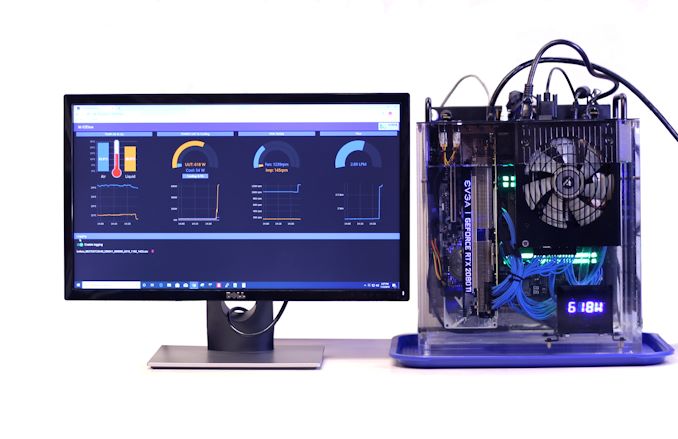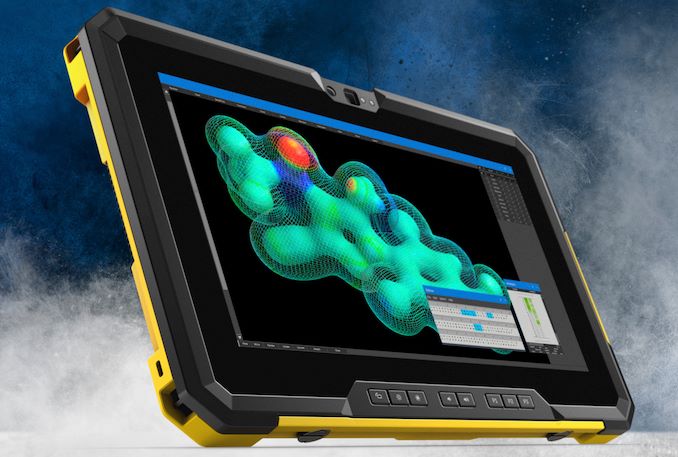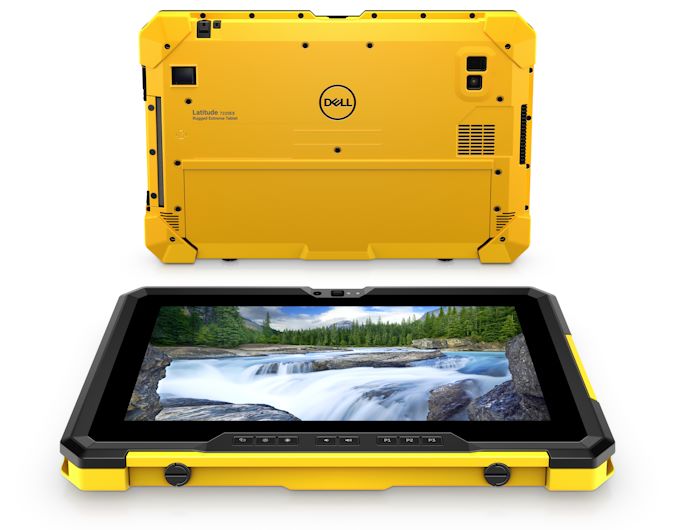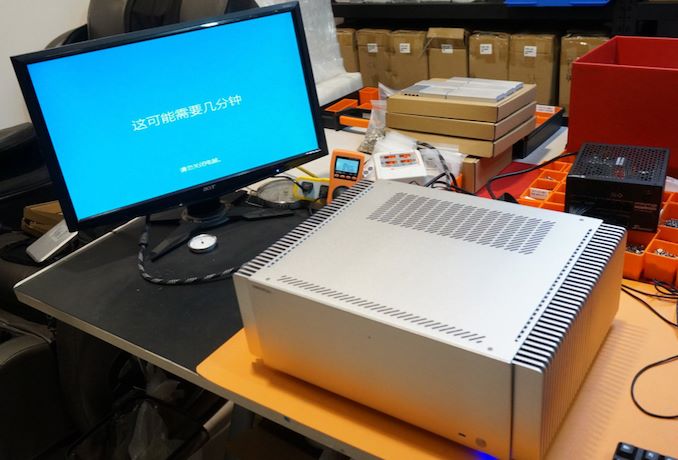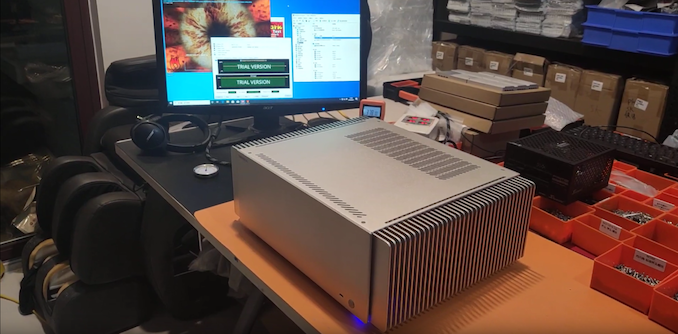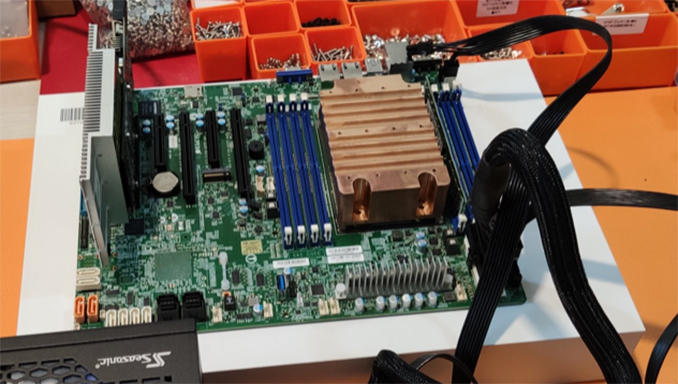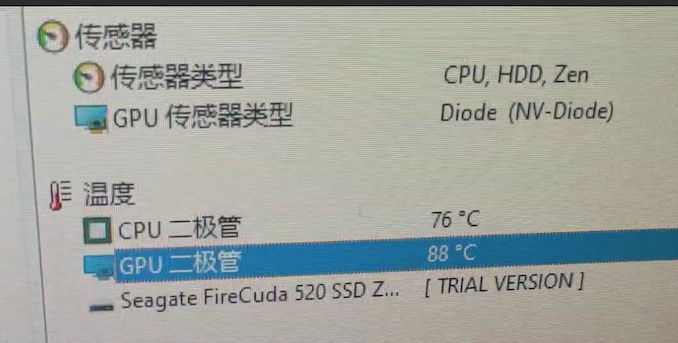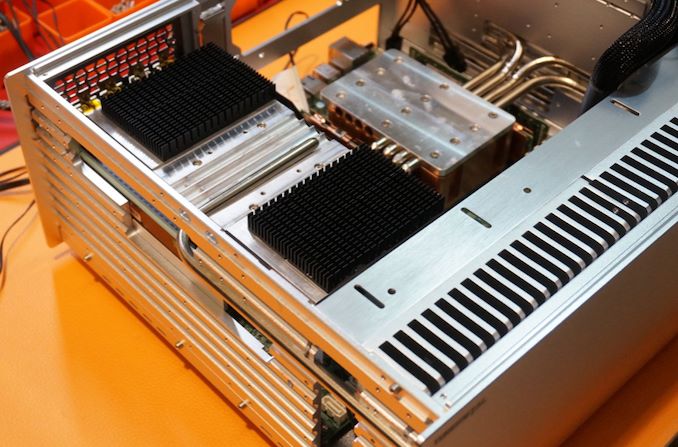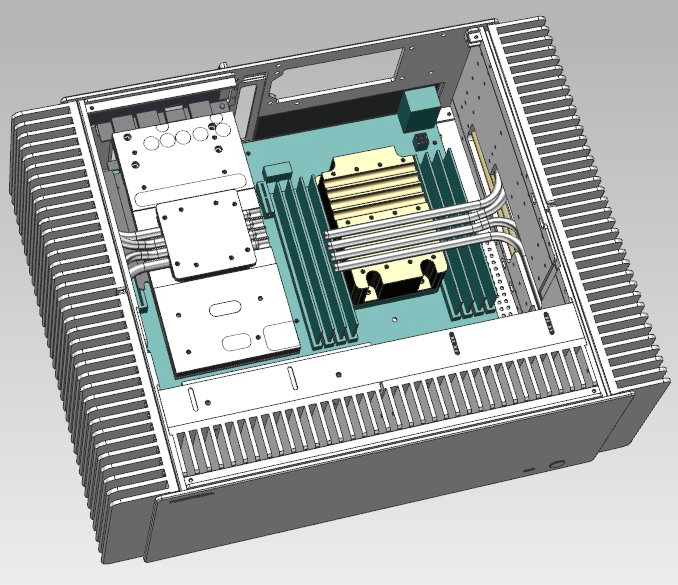Tuesday 31 December 2019
AMD's 48-core Ryzen 3980X monster CPU has been reportedly found in CPU-Z's code
AMD's pushing Threadripper to new heights in 2020.
from Overclock3D.Net https://ift.tt/2SGhLaA
via IFTTT
The best free screen recorder 2020: record or stream from your screen
We've tested and ranked the best free screen recorders that make it easy to record everything that's happening on your PC, complete with commentary and annotations if you want.
It's important to choose the right free screen recorder depending on what you intend to do with the footage you capture. Different recorders offer a range of differing features, can save captures in varying formats, or capture footage from external sources such as a webcam – and some even give you the opportunity to upload to the internet directly from within the program. Some run nicely on average hardware, while others are more demanding. The point is that there is plenty of choice.
No matter what you're hoping to do with footage captured from your computer, you need the right tool for the job. And this is where our look at the best free screen recorders can help – take a look and see which one is best for you.
The best free screen recorders at a glance

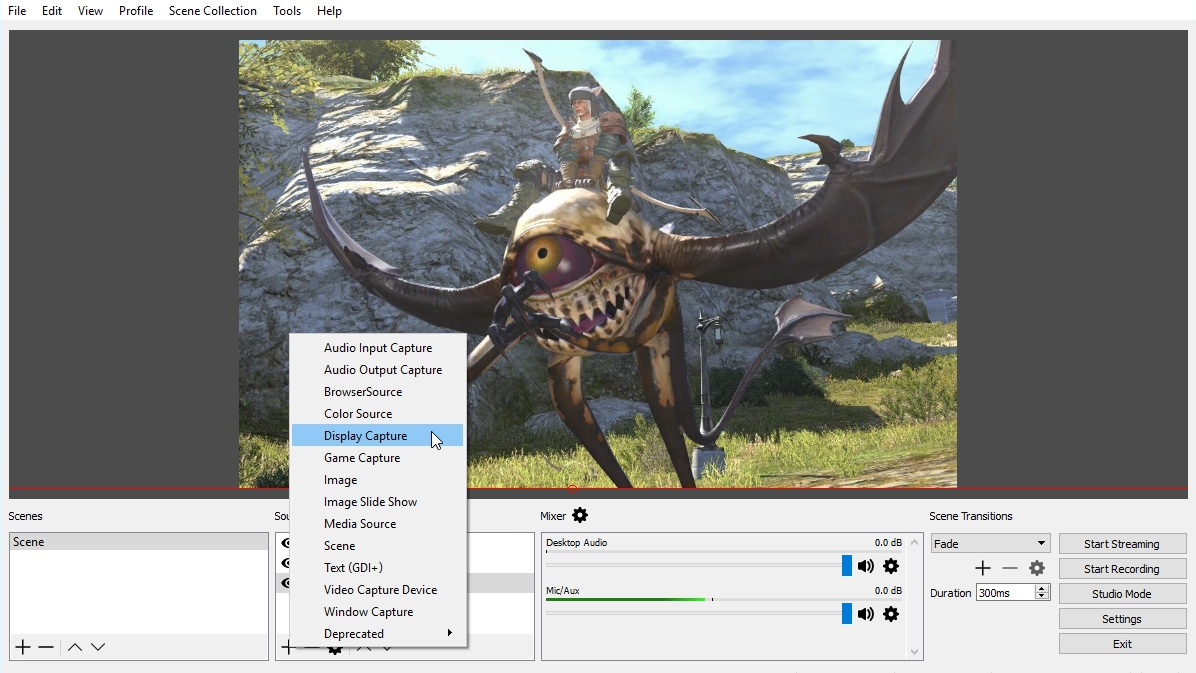
If you’re a keen gamer, OBS Studio is easily the best screen recorder for you. Unlike the hugely popular FRAPS (which only lets you record for 30 seconds at a stretch unless you’ve bought a license, and applies a watermark to the resulting footage), OBS Studio is open source, and completely free to use without restrictions.
OBS Studio supports both streaming and recording in high definition, with no restrictions on the number or length of your creations. You can stream live to Twitch or YouTube gaming, save projects and come back to them later, or encode your footage in FLV format and save it locally.
Because OBS Studio can record directly from your graphics card, it’s able to capture games running in full-screen mode (many other screen recorders can only record if the game is windowed), with customizable hotkeys to control the recording. OBS Studio can also make full use of multi-core CPUs for improved performance, and can record at 60FPS (or even higher).
It might take a little while to set it up exactly how you want, but OBS Studio is by far the best and most powerful screen recorder for gamers.
Read our full review: OBS Studio

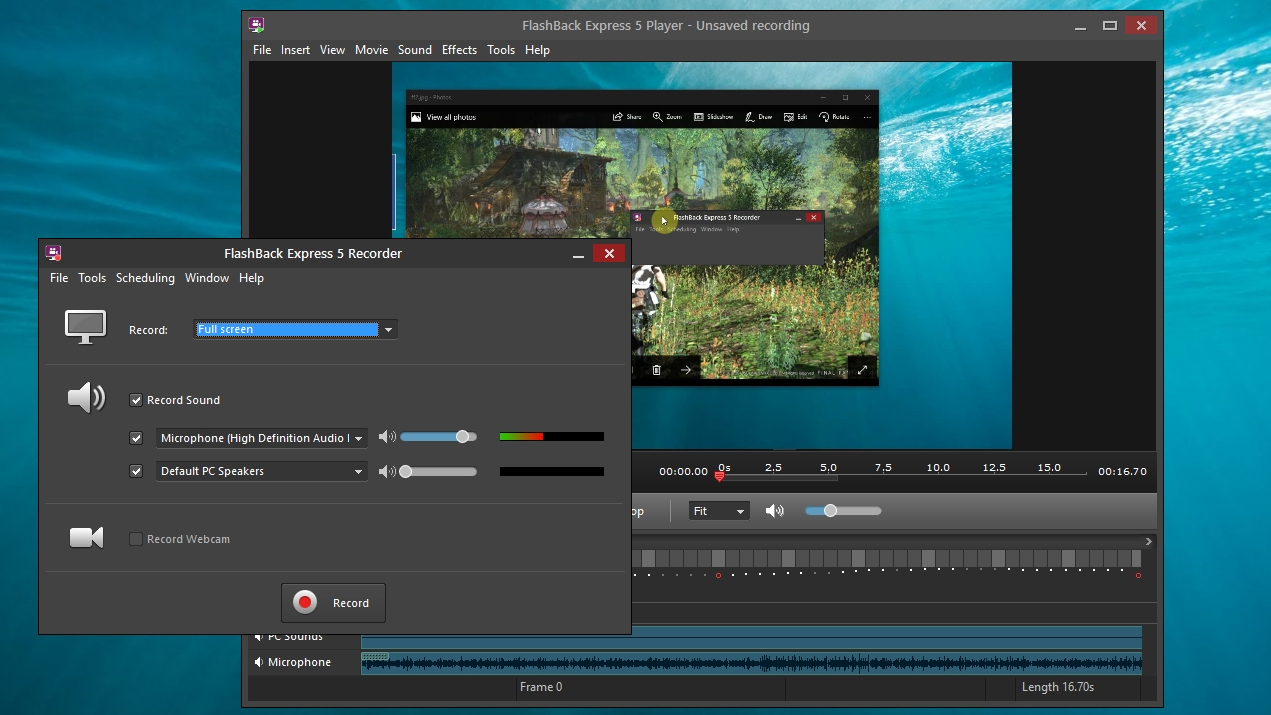
OBS Studio is our top choice for recording from a desktop or webcam, but Flashback Express comes an extremely close second. Despite being a free version of a paid program, FlashBack Express won't put ugly watermarks over your recordings or impose time limits, and it's packed with features and tools that rival many premium programs. Its interface is less intimidating than OBS Studio, so if you've never used a screen recorder before, it's an excellent choice.
You can record from your whole screen, a window, a selected area, or a webcam. Once you’ve finished, your recording will appear in a simple editor, where you can crop and trim it to suit your needs, then export it to YouTube, an FTP server, or your PC.
That’s all fairly standard fare for a free screen recorder, but take a minute to dive into Flashback’s advanced options and you’ll find a wealth of thoughtfully designed settings that will make your desktop recordings look truly professional. The recorder can automatically obscure passwords entered on screen, replace your silly wallpaper with a plain one, hide messy desktop icons, and highlight your mouse pointer to make it easier to follow. There's also a dedicated gaming mode that lets you define the number of frames recorded per second.
There’s no limit on the length of your recordings unless you choose to set one, which can be useful if there’s a chance you might accidentally leave the recorder running. You can also choose to break long recordings up into chunks – a brilliant touch that helps you avoid creating huge, unwieldy files. Your recordings won’t be watermarked, either.
Following a recent update, Flashback Express can export in WMV, AVI and MP4 formats, eliminating the need for a separate video converter, and it no longer requires a free license key for activation – just install the software and you're ready to start recording.
Developer Blueberry Software has also released a free screen recorder designed specifically for games – FBX. This recorder captures HD in-game footage, with hardware acceleration for AMD and Nvidia cards, and Intel CPUs.
If you're thinking about upgrading to FlashBack Pro, Blueberry software is offering TechRadar readers an exclusive 25% discount.
Read our full review: Flashback Express

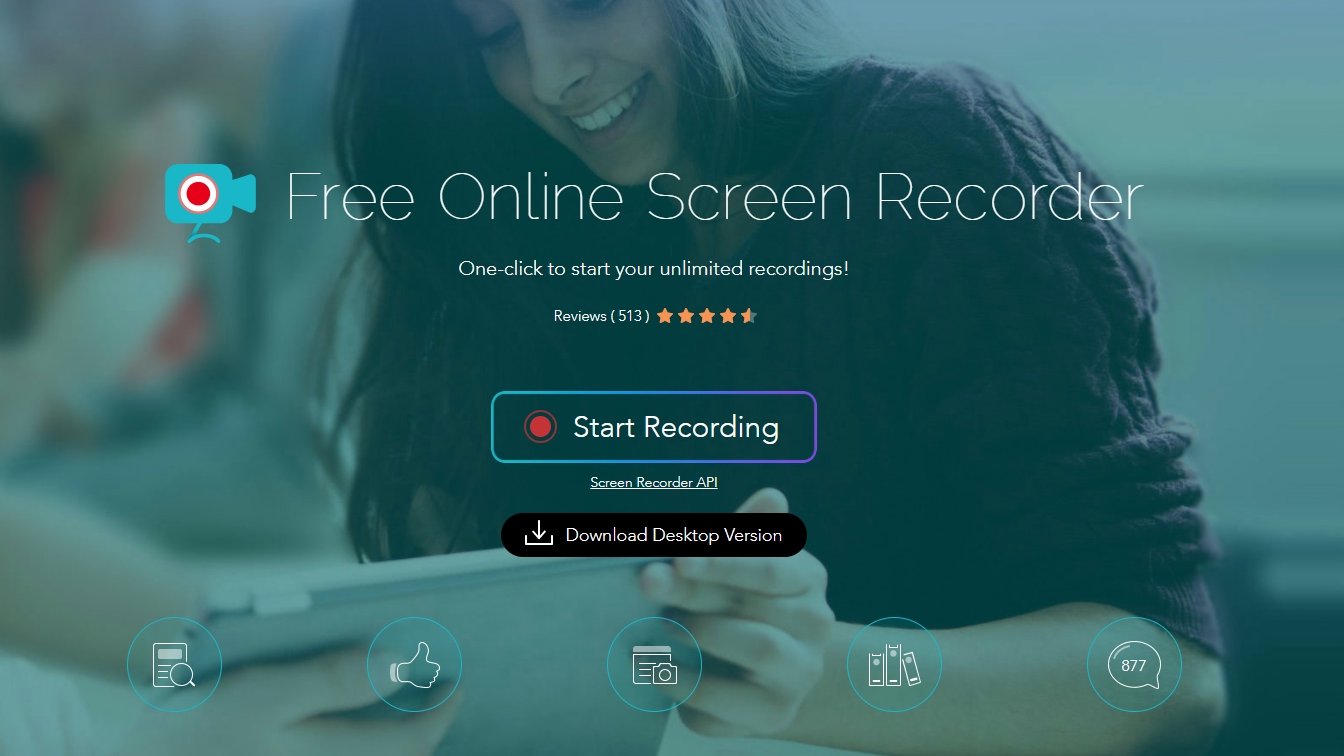
If you want to record a presentation, software demonstration or tutorial, give Apowersoft Free Online Screen Recorder a try. It's a browser-based tool, which means it's not suitable for games, but for any other tasks it's ideal.
The first time you use Apowersoft Free Online Screen Recorder, you'll be prompted to download a small launcher application. You'll then be provided with a control bar packed with more options than you'll find in most desktop screen recording software. You can capture footage from your desktop or a webcam, and record audio from your PC, microphone, both or neither.
You can record the whole screen, select an area manually or choose one of the preset resolutions – ideal if you’re recording a clip for YouTube, for example, and don’t want to use a separate video editor to resize it later.
Apowersoft Free Online Screen Recorder also offers customizable keyboard shortcuts for speed and convenience. You can choose whether or not to include the cursor in the recording and take your pick from a range of output formats including MP4, WMV, AVI, MOV and many more. You can even add annotations during the recording.
Once you’re done, you can save the recording as a video file or GIF, upload it directly to YouTube or Vimeo, or send it to Google Drive or Dropbox. You can also edit the clip. Selecting this option will download an additional component – Apowersoft Video Editor – which lets you make simple adjustments before exporting your video in your preferred format. A truly exceptional tool.
Note that the 'Download desktop version' button links to a program called Apowersoft Screen Recorder Pro. This is a trial version of a premium application, and is more limited than Online Screen Recorder.
Read our full review: Apowersoft Free Online Screen Recorder


Debut Video Capture is a new addition to our roundup of free screen recorders, and although its slightly dated design does it few favors, it's an extremely powerful program that can do much more than just capture what's happening on your PC monitor.
In addition to basic screen recording (with no time limits or watermarks), Debut Video Capture can also record footage from external devices, including webcams and security cameras. It can even record on a regular schedule, which means it can become the main hub of a home security system. Not too shabby for a program that's totally free for personal use.
There are no post-production editing tools, but you can apply filters and add your own captions and watermarks before you begin recording. There's no option for exporting videos directly to YouTube or Facebook, but they can be saved in all the main formats, including MP4, MOV and AVI (to name just three).
Debut Video Capture is currently in public beta, so we look forward to seeing the final release version with a lick of extra polish soon.
Read our full review: Debut Video Capture

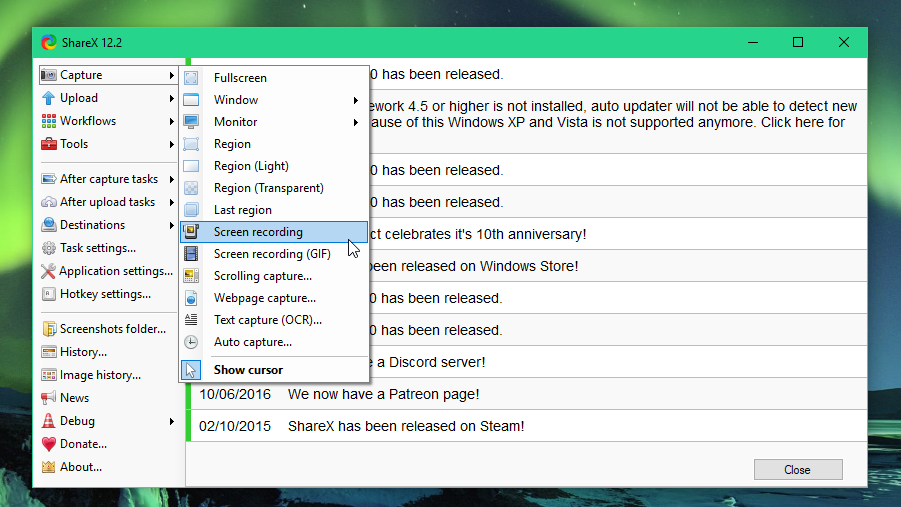
ShareX is an open source app for capturing still screen grabs and recording videos. There are no watermarks or time limits to worry about, but the interface isn't the most intuitive in the world so you’ll be best off using keyboard shortcuts. For quick reference, you can start a recording by tapping Shift + Print Screen, and stop it again using Ctrl + Shift + Print Screen.
You can also use this free screen recorder to save your capture as a GIF rather than a video file, which can be extremely useful for sharing on forums and social media.
Not only is ShareX a brilliant free screen recorder, it can also capture an entire scrolling webpage, capture and identify text via OCR, and even capture your screen according to a schedule.
Another of its best features is the ability to send your captured grabs and videos straight to a file-sharing or social media site. There’s a vast array of options, which you can check out on the project’s site.
Unfortunately, ShareX doesn’t support taking screen grabs or recordings from games running in full-screen mode. Other than that, it’s a superb screen recorder that will serve you extremely well.
Watch our rundown of our favourite free video editors:
- Read more: our guide to the best free video editing software
from TechRadar: computing components news https://ift.tt/2mUsFqf
via IFTTT
Monday 30 December 2019
Intel is coming for AMD if these leaked Comet Lake specs are any indication
Just a little while ago we were able to catch a glimpse of the Intel Core i3-10300, a hyperthreaded entry-level chip from the upcoming Intel Comet Lake-S lineup. But, now, thanks to a new leak, we may have seen the entire range of 10th-generation desktop processors.
Some leaked slides from Intel appeared on Informatica Cero showing a broad lineup of desktop processors, from the 4-core, 16-thread Intel Core i3-10100 to the 10-core, 20-thread Intel Core i9-10900K. If these leaks are to be believed, we should see some much improved multi-core performance out of Intel in 2020.
- Here are the best processors
- We'll show you how to build a PC
- There's a whole world of PC components out there
But the leaks go even further. In some now-removed slides on VideoCardz, we got to see some more detailed information about the new lineup. For instance, Comet Lake-S processors will apparently feature up to a 4.8GHz all-core turbo, which will result in some extremely fast performance when the processors are pushed to their limits. What we don't know yet is if it'll hold a candle to AMD.
Here are the processors that were leaked, along with their single-core Turbo speeds:
- Intel Core i3-10100: 4 cores, 8 threads 4.3GHz Turbo
- Intel Core i3-10300: 4 cores, 8 threads, 4.4GHz Turbo
- Intel Core i3-10320: 4 cores, 8 threads, 4.6GHz Turbo
- Intel Core i5-10400: 6 cores, 12 threads, 4.3GHz Turbo
- Intel Core i5-10500: 6 cores, 12 threads, 4.5GHz Turbo
- Intel Core i5-10600: 6 cores, 12 threads, 4.8GHz Turbo
- Intel Core i5-10600K: 6 cores, 12 threads, 4.8GHz Turbo
- Intel Core i7-10700: 8 cores, 16 threads, 4.8GHz Turbo
- Intel Core i7-10700K: 8 cores, 16 threads, 5.1GHz Turbo
- Intel Core i9-10900: 10 cores, 20 threads, 5.1GHz Turbo
- Intel Core i9-10900K: 10 cores, 20 threads, 5.2GHz Turbo
According to these leaked slides, core counts see a modest bump up from 8 cores to 10 in the flagship Core i9-10900K. But unless the processor sees a healthy price cut a lá Cascade Lake-X, we're not sure how well it will hold up against AMD Ryzen 3rd Generation processors, the flagship of which has 16 cores.
Another mystery here is how much further Intel can push performance without it moving to 10nm. Comet Lake will still be based on Intel's 14nm manufacturing process, and we just have to wonder just how much further speed and efficiency can be pushed there.
Either way, with how fast these leaks are coming out, our guess is that we'll learn much more about these processors at CES 2020, which is rapidly approaching.
- Check out the best graphics cards
from TechRadar: computing components news https://ift.tt/39tr8jI
via IFTTT
Taking Immersion in Gaming One Step Further: Full PC Immersion with the CoolBitts ICEbox
One of the news items that went under the radar at Supercomputing was from CoolBitts. The company focuses on fully immersed systems whereby the CPU, GPU, and all the components are put into a non-conductive liquid. There are two types of immersive systems: two phase, where the liquid turns to a gas on heating and then condenses back into a liquid, or single phase systems that rely on a pump and a radiator to help move the liquid. This is the latter, and if you’ve ever heard of the ‘mineral oil’ PC, this is something very similar, except this is a case and coolant dedicated for immersion systems.
from AnandTech https://ift.tt/37qY1fs
via IFTTT
Best dedicated server hosting providers of 2020
Opting for a dedicated server means that you get an entire server to yourself. There's no sharing of CPU time, RAM or bandwidth, which means your website stays responsive at all times.
Shared web hosting can appear to be amazing value, with feature-packed products available for just a few pounds every month. But the reality is often very different, and they're not always the bargains they seem.
Very low prices probably mean the host is cramming more customers onto each server, for instance. Performance will be poor as there aren't enough resources to go around, and the extra load could mean more server problems and downtime.
Dedicated hosting implies that you also get far more control over how the server is configured. You can add and remove software, install updates or tweak all settings, allowing you to optimize the server for your specific needs.
Best of all, dedicated hosting contracts often come with fast and knowledgeable support. The best providers will even monitor your server for issues, like failed services, and can often fix them before you've realized there was a problem.
This kind of power doesn't come cheap, and although there are some good signup deals around, you can easily spend $50-$140 a month and more on just a basic package.
With that kind of investment, it's important to make the right choice. In this article, we're going to highlight five top dedicated hosting providers who you might want to check out first.
- Also check out the best web hosting services
- Here is a list of the best VPS providers as well
- Head this way for the best cheap dedicated server deals


Bluehost is a popular web hosting service with powerful and flexible plans, and their dedicated hosting plans follow the same principle.
The pricing starts with the Standard plan which is priced at $73.99 (£61.85 for UK) per month for the first term, $119.99 (£98.64 for UK) per month afterward. The plans might be a bit more expensive compared to rivals but they sure don’t lack the features. For the Standard plan you get 4 cores at 2.3 GHz, 500GB of storage, 4GB RAM, 5TB bandwidth and 3 IP addresses. Free domain and SSL certificate are also included.
In addition, there are plenty of advanced features too, like multi-server management, secure shell (SSH) access, custom-designed database manager and more. For users that want more, they have the option to upgrade to a faster CPU, more storage, more bandwidth and pretty much more of everything.
Some optional features are also available, so if you want domain privacy and protection, SiteLock or spam protection you can get those as well.
Bluehost is a capable hosting provider with 24/7 support so you can call for help any time you need it. If by any chance you’re not satisfied with the service, Bluehost offers a 30-day money-back guarantee.

Hostwinds is a capable hosting provider which crams a huge range of features into all its products, from the most basic shared hosting plans to its enterprise-level cloud-based range.
Its dedicated server range may start at just $79.50 (£60.6) a month, for instance – $106 (£76) on renewal – but even these baseline products include features that are premium extras elsewhere.
All systems have 1Gbps ports, for instance (some providers start at 100Mbps). Every server is fully managed, ensuring you're not wasting time running operating system updates or other basic maintenance tasks. Hostwinds monitors your server to detect problems as soon as they crop up, and automatic nightly backups ensure you can quickly recover from even the worst of disasters.
Storage is extremely configurable, too. Some servers have four drive bays available, and they can be equipped with any mix of 1TB to 3TB SATA drives, or 120GB to 1TB SSDs. That's considerably more flexible than providers like 1&1, where you can only use SSD drives on some products, and even then they're often available in fixed configurations only (1TB SATA or 800GB SSD, for instance).
There's more good news with the choice of operating system. Not only do Linux fans get a choice of CentOS, Debian, Fedora or Ubuntu, but Windows users can choose Windows 2008, 2012 or 2016 Server for a low $25 (£18.8) – we've seen charges of up to $50 (£35.70) elsewhere.
Put it all together and the Hostwinds dedicated range is refreshingly honest. Servers aren't crippled by low specifications to hit a price point, and yet final costs remain low, with most updates very fairly priced. Well worth a look for anyone who needs a reliable, highly-specified server for a low price.

German-based 1&1 (as October 2018 called 1&1 IONOS) is well known as a budget hosting provider, but the company doesn't just offer value for website newbies: its dedicated server range starts at a very low $45 a month for the first six months, then $65.
As you might imagine, 1&1 has had to cut a few corners to hit that price point. The cheapest plans are relatively basic, with limited hardware, although network bandwidth got an upgrade with 1Gbit/s. Features like SSD drives and server management (1&1 updates, monitors and manages the server for you) cost extra. Oh, and there's also a setup fee of at least $50 (entry level plan doesn't have setup fee).
But there are plus points, too, including unlimited bandwidth, bundled Symantec SSL certificates, and the Plesk Onyx server control panel thrown in for free. Overall, even the most limited 1&1 dedicated server plan has enough power to handle many tasks. Additionally, you get a personal consultant free of charge.
Demanding users have plenty of paid upgrades to explore, including a faster CPU, more RAM and storage, a bundled backup service and more. Some of these add-ons include more than you might expect, too. Paying $14 a month for management doesn't just mean 1&1 will look after server admin: you also get a website builder, simple analytics, a photo slideshow service, automatic backup and restore for WordPress sites, and more. Sounds like a good deal to us.

Opting for dedicated rather than shared hosting will speed up your website in itself, but there's still plenty of room for improvement. A2 Hosting's managed server plans blend multiple tricks and technologies to try and ensure you see the best possible performance.
This starts with a powerful set of server components: OPcache and APC may speed up PHP processing by 50%. Memcached holds key MySQL data in RAM for faster retrieval, while mod_pagespeed uses multiple tricks to optimize site content. SPDY and HTTP/2 accelerate page loads even further, and support for technologies like edge side includes and websockets allow more fine-tuned optimizations of your site.
A2 Hosting plans also include Cloudflare's free CDN and its Railgun Optimizer, which "compresses previously uncacheable web objects up to 99.6%" and may result in an average 200% performance increase. In reality you might not see anything like that – the boost will vary greatly, depending on your site – but it's still a technology worth having.
Elsewhere, performance-boosting add-ons include RAID 1 SSD storage of up to 2 x 1TB. An optional Turbo Boost feature costing from $35 a month replaces Apache with the LiteSpeed server, apparently bringing up to 20x faster page loads, and another add-on can cache the HTML contents of a page, then speedily reload it later without needing to run PHP. We were happy to see cPanel is thrown in, too (it's often a chargeable extra with other hosts).
These kind of professional features come at a cost, with even the most basic Sprint plan priced from around $99 a month. But if speed is your top priority then this company could be worth a try, especially as A2's ‘Anytime Money Back Guarantee’ will refund your fees if you cancel within 30 days of your order.
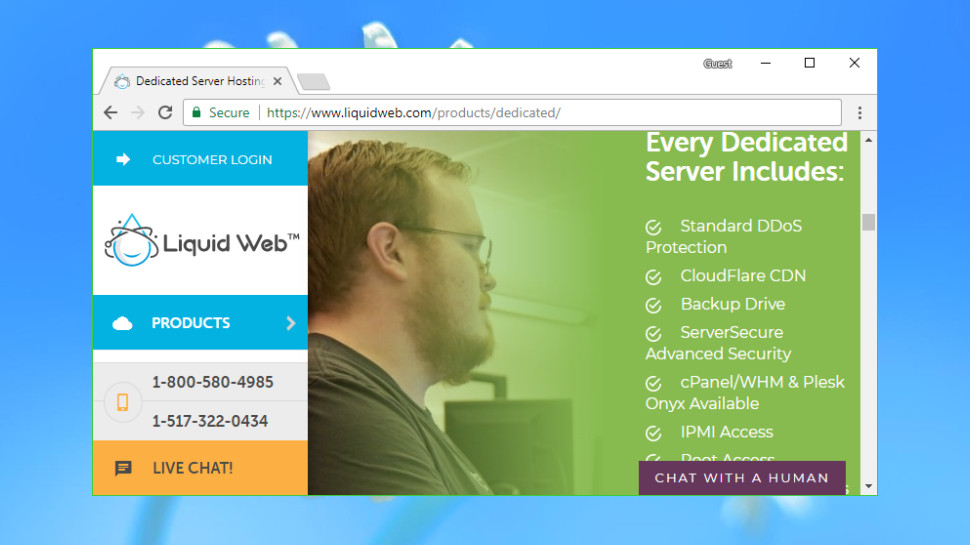
Liquid Web is a popular provider of high-end business hosting products ranging from managed WordPress and WooComerce plans, to cloud VPS, dedicated servers and private clouds.
The company's dedicated offerings may look expensive, with a starting price of $199 a month (can be reduced to $149 a month if annual billing is chosen), but they're also far better specified than most of the budget competition.
Even the cheapest dedicated server includes two speedy 240GB SSD drives, for instance. There's also a 1TB SATA backup drive provided, making it easy and convenient to run regular backups.
The plan includes a dedicated IP. Support for Cloudflare CDN should boost your website speeds, and your server can be hosted in one of three data centers (Arizona, Michigan, or the Netherlands). Although, the special entry plans are only hosted in Michigan.
Most importantly, all dedicated servers are managed by Liquid Web's professional support team. They monitor system health, proactively respond to notifications (for example, they’ll restart a failed service), alongside taking care of installing and updating the operating system. If you have any difficulties, support is available 24/7/365, and the company guarantees a 59 second response time via phone or chat, 30 minutes via ticket and email.
Factor in the wide range of optional add-ons – load balancers, firewalls, VPN – and the range has more than enough power for almost any purpose. If you're managing a heavy-duty website, Liquid Web needs to be on your shortlist.
You might also want to check out our other website hosting buying guides:
- WordPress
- Cloud hosting
- E-commerce
- Small business
- Windows
- Managed
- Green
- Business
- Colocation
- Email hosting
- Resellers
- VPS
- Shared
- Cheap
- Website builders
- Best website hosting
- And we consider the merits of shared hosting vs dedicated hosting here
from TechRadar: computing components news https://ift.tt/2Gzofmo
via IFTTT
For Explosive Environments: Dell Latitude 7220EX Rugged Extreme Windows Tablet
With industry and research, computers are needed everywhere, including various harsh environments for which companies develop ruggedized PCs, tablets, or smartphones. But there are also hazardous environments that not only pose danger to devices for whatever reasons, but which are potentially explosive because they are filled with gases, vapors, combustible gases, and other flammable components. The use of regular electronics in such environments is dangerous, but Dell has developed its Latitude 7220EX Rugged Extreme Tablet just for this purpose.
The Dell Latitude 7220EX Rugged Extreme Tablet is designed for engineers working in agriculture, chemical, manufacturing, and oil & gas sectors who encounter potentially explosive environments every day. To meet their safety requirements, Dell took its recently introduced Latitude 7220 Rugged Extreme Tablet and redesigned it in order to eliminate any possibility that the device could be the source of an explosion (which may be caused by an overheating or malfunctioning component, a spark caused by an unsealed electric circuit or whatever other reason).
To ensure that the Latitude 7220EX Rugged Extreme Tablet is safe and meets all formal safety requirements in the North America, Europe, and other parts of the world, the machines are Class 1, div 2 certified in NA, ATEX certified in the EU, and IECEx certified for International markets. Meanwhile, in a bid to incorporate
Since the Latitude 7220EX Rugged Extreme Tablet is a version of the non-EX model, their technical specifications are very similar. The tablet is equipped with an 11.6-inch Full-HD display with 1000 nits brightness to make it usable even under direct sunlight. Inside the tablet designed for the most extreme environments is Intel’s Core i7-8365U (Whiskey Lake) processor with four cores and Intel’s UHD Graphics 620. The SoC is accompanied by 8 GB of LPDDR3-2133 memory and a 512 GB Class 40 M.2 SSD with a PCIe 3.0 x4 interface.
When it comes to wireless connectivity, the machine is equipped with Intel’s AX200 Wi-Fi 6 + Bluetooth 5.0 adapter, and Qualcomm’s Snapdragon X20 4G/LTE modem. On the wired side of I/O matters, the Latitude 7220EX Rugged Extreme Tablet includes a USB 3.1 Type-C connector that can be used for charging and external display connectivity, a USB 3.0 Type-A port, a micro RS-232 port, a POGO connector for the keyboard, an SD card reader, and a 3.5-mm audio jack for headsets. Interestingly, the tablet also retains all the imaging and multimedia capabilities of the original one, which includes Windows Hello-compatible front camera, a rear camera with a flash, and stereo speakers. As for security, the machine is equipped with a fingerprint reader, Dell’s ControlVault advanced authentication, Intel vPro remote management, a TPM 2.0 module, optional encryption for SSDs, and NIST SP800-147 secure platform.
Dell’s Latitude 7220EX Rugged Extreme Tablet is powered by two hot-swappable batteries, each with a 34 Wh capacity, but the manufacturer does not disclose battery life of the device because special-purpose software used by the target audience will have different effects on power draw.
.
| Specifications of the Dell Latitude 12 Rugged Extreme Tablets | |||
| Latitude 7220EX Rugged Extreme |
Latitude 7220 Rugged Extreme |
||
| LCD | Diagonal | 11.6" | |
| Resolution | 1920×1080 | ||
| Features | Brightness: 1000 cd/m² Outdoor-readable, anti-glare, anti-smudge, polarizer, glove-capable touchscreen |
||
| CPU | Intel Core i7-8665U: 4C/8T vPro | Intel Core i7-8665U: 4C/8T vPro Intel Core i5-8365U: 4C/8T vPro Intel Core i3-8145U: 2C/4T |
|
| Graphics | Intel UHD Graphics 620 (24 EUs) |
||
| RAM | 8 GB LPDDR3-2133 | 8 GB or 16 GB LPDDR3-2133 | |
| Storage | Class 40, 512 GB, PCIe 3.0 x4 | M.2 PCIe 3.0 x4 SSDs: Class 35: 128 GB; Class 40: 256 GB, 512 GB, 1 TB, 2 TB; Class 40 SED: 256 GB, 512 GB, 1 TB. |
|
| Wireless | Wi-Fi, Bluetooth options |
Intel Wi-Fi 6 AX200, 2x2, 802.11ax with MU-MIMO, Bluetooth 5.0 | Wireless LAN Options: Intel Wireless-AC 9560, 2x2, 802.11ac with Bluetooth 5.0 Intel Wi-Fi 6 AX200, 2x2, 802.11ax with MU-MIMO, Bluetooth 5.0 Intel Wi-Fi 6 AX200, 2x2, 802.11ax with MU-MIMO, without Bluetooth |
| Mobile Broadband (optional) |
DW5821E Qualcomm Snapdragon X20 4G/LTE Wireless WAN card for AT&T, Verizon, Sprint | optional DW5821E Qualcomm Snapdragon X20 4G/LTE Wireless WAN card for AT&T, Verizon, Sprint | |
| GPS | Dedicated u-blox NEO-M8 GPS card | ||
| Additional | ? | ? | |
| USB | 3.1 | 1 × USB 3.0 Type-C w/ DP, PD | |
| 3.0 | 1 × USB 3.0 Type-A | ||
| Cameras | Front | 5 MP RGB + IR FHD webcam with privacy shutter | |
| Back | 8 MP rear camera with flash and dual microphone | ||
| Security |
Steel reinforced cable lock slot TPM 2.0; |
Steel reinforced cable lock slot Optional Security includes: TPM 2.0; ControlVault advanced authentication; Dell Security Tools; Dell data protection encryption Contactless/Contacted SmartCard reader; Fingerprint reader; NIST SP800-147 secure platform; Dell Backup and Recovery. |
|
| Other I/O | TRRS audio jack, micro RS-232, SD Card reader, etc. | TRRS audio jack, micro RS-232 (optional), POGO, SD Card reader, etc. | |
| Battery | Dual Hot-swappable 34 Whr, 2 Cell, ExpressCharge, Lithium Ion Battery or Dual Hot-swappable 34 Whr, 2 Cell, Long Lifecycle |
34 Wh Primary (ExpressCharge) 34 Wh Secondary (optional?) |
|
| Dimensions | Width | 323.4 mm | 12.73 inch | 312.2 mm | 12.29 inch |
| Height | 214.2 mm | 8.43 inch | 203 mm | 8 inch | |
| Thickness | 26.2 mm | 1.03 inch | 24.4 mm | 0.96 inch | |
| Weight | 1650 grams | 3.65 lbs (tablet) | 1330 grams (tablet) | |
| Operating System | Microsoft Windows 10 Pro 64 Bit | ||
| Regulatory and Environmental Compliance | MIL-STD-810G | Transit drop (48”/1.22m; single unit; 26 drops), operating drop (36”/0.91m), blowing rain, blowing dust, blowing sand, vibration, functional shock, humidity, salt fog, altitude, explosive atmosphere, thermal extremes, thermal shock, freeze/thaw, tactical standby to operational. |
|
| Operating thermal range | -20°F to 145°F (-29°C to 63°C) | ||
| Non-operating thermal range | -60°F to 160°F (-51°C to 71°C) | ||
| IEC 60529 ingress protection | IP-65 (dust-tight, protected against pressurized water) | ||
| Hazardous locations | ATEX, IECEx certification for Zone 2 and Zone 22; ANSI/ISA.12.12.01 certification (Class I, Division 2, Groups A, B, C,D) | ANSI/ISA.12.12.01 certification capable (Class I, Division 2, Groups A, B, C,D) | |
| Electromagnetic interference | MIL-STD-461F and MIL-STD-461G | ||
| Optional Accessories | ? | Rugged Tablet Dock Keyboard with Kickstand Havis Vehicle Dock PMT Vehicle Dock Gamber-Johnson Vehicle Dock Carrying accessories Scanner module Extended I/O module Dell monitors (with USB-C or over a USB-C-to-DP adapter) Dell wireless keyboard and mice |
|
| Price | ? | Starting at $1,899 | |
Dell will start sales of the Latitude 7220EX Rugged Extreme Tablet in the near future. Pricing will depend on exact configurations and region.
Related Reading:
- Dell’s Latitude 7220 Rugged Extreme Tablet Gets Quad-Core CPUs & 1000-Nits Display
- Dell Launches Three Rugged Latitude Laptops with up to 1000-nit Displays
- Dell Latitude 12 Updated: Rugged Tablet Gets Faster CPU, FHD LCD, Lower Weight, USB-C
- Cat at MWC 2018: S61 Smartphone with FLIR Cam, Laser Distance Measurer, Air Quality Sensor
- Innodisk Unveils Fire Shield SSD: Withstands 800°C Temperature & Direct Flames
Source: Dell
from AnandTech https://ift.tt/2rEdHwo
via IFTTT
Best cloud hosting services in 2020
Signing up for a simple web hosting package will usually buy you a defined block of resources on a single server: this much web space, that much bandwidth, maybe a set amount of RAM or CPU cores.
While this works well for many websites, having fixed resources can be a problem for larger projects. There's generally no way to temporarily allocate extra RAM or bandwidth if you experience an increase in traffic, and even a simple plan upgrade might require your website to go offline for a while.
Cloud hosting plans look much like virtual private server (VPS) products, where you'll initially pay for a set amount of web space, RAM, CPU time and bandwidth. But these resources are spread across multiple devices instead of just one, and changing your plan later – adding another gig of RAM, for instance – is generally as easy as dragging a slider, with the extra power coming online within moments.
This flexibility is great for delivering extra power when you need it most, and starting prices can be similar to regular VPS hosting (from £10 or $14 a month). Costs will rise as you add resources, but typically you'll only pay for the time in which you use these resources.
DigitalOcean's monster 192GB RAM, 32 vCPU and 3,840GB SSD product costs $960 (£685) a month, for instance, but this pay-as-you-go approach allows you to try it out for $1.429 or £1.02 an hour.
Cloud hosting still won't be for everyone, and small, simple websites are likely to be better off with regular packages. But the technology has a lot to offer anyone with larger or more ambitious projects, and many hosts run free trials which make it easy to explore their abilities for yourself.
Best cloud hosting - at a glance
- Micrososft Azure
- Hostgator
- Cloudways
- Clook
- DigitalOcean
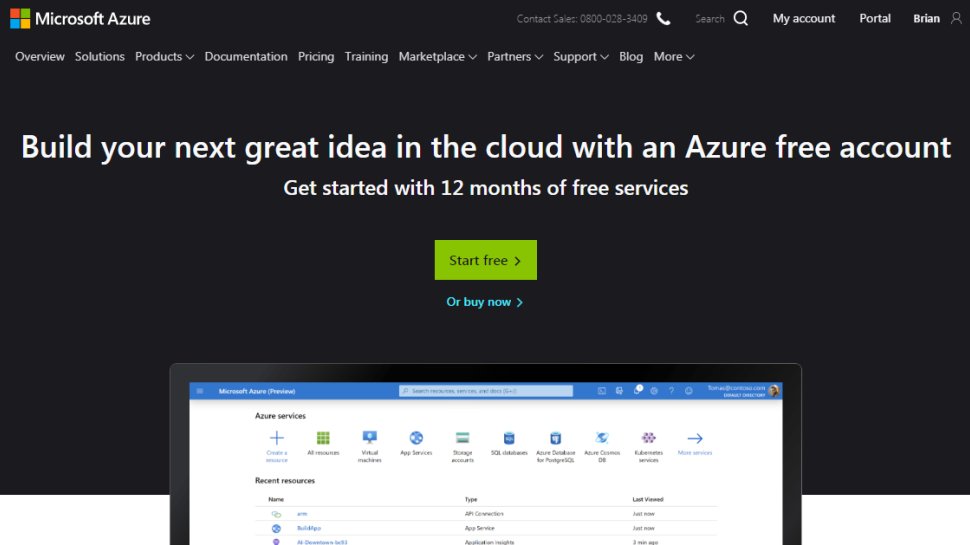
If you're looking to move your business hosting into the cloud, one of the first places to consider is one of the big cloud computing platforms, such as Microsoft Azure.
This isn't a solution for small businesses looking to simply host a website, but it's a great place to go if you have additional computing needs as well and you want to bundle everything together into a single place. The advantage then is that you can move all your business data and apps into the cloud and run them from a single unified platform.
Additionally, by keeping to a single provider you can avoid all the complications of having to deal with cloud management for hybrid clouds and on-premises data. On top of this, Azure boasts more compliance and security certifications than any other cloud provider.
However, moving to a major cloud platform isn't for the faint-hearted, but if you have the IT skills in house, or if you can utilize third-party cloud support services, the move could make a lot of sense even for smaller businesses with a lot of data.
And for the larger small business up through medium to enterprise businesses, the move the a cloud platform like Azure may be a case of 'when' rather than 'if'.
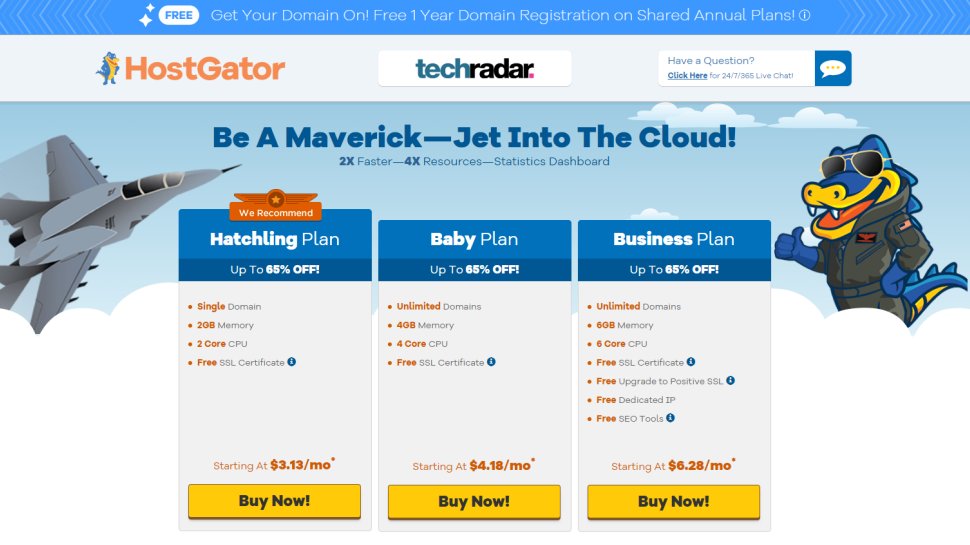
If you only need to host a website rather than additional business data, then HostGator's cloud platform could be a more ideal choice. Unlike normal web hosting, Hostgator's cloud hosting platform spreads your website load across multiple virtual server instances for more reliable and scalable hosting, but it's as easy to use as standard shared hosting, and only costs a little more.
For example, the baseline Hatchling Cloud plan gets you support for one domain, unmetered bandwidth and storage, a share of up to two cores and 2GB RAM, and distributed Varnish caching to speed up the loading of static content. You can get started for as little as $3.13 (£2.50) a month if you buy three years upfront, although the price leaps to $8.95 (£6.40) on renewal.
If you need something more powerful, the top-of-the-range Business Cloud plan supports unlimited domains, gives you up to six cores and 6GB RAM, and includes private SSL and a dedicated IP. Another chunky introductory discount means you can pay as little as $6.28 (£5.10) a month over three years, but after that you'll pay $17.95 (£12.80) per month.
Benefits of the cloud plans include (up to) twice as fast load times, along with more site statistics, and because your site is mirrored across multiple devices, the ability to switch your site to another server in the event of a hardware failure.
But the key advantage of all cloud hosting schemes is scalability. If your site can't cope with demand, you can scale up to eight cores and 8GB RAM with a click. There's no waiting around for someone to process your order and no downtime while your web space is reallocated – you get the extra resources right away.
Also, while prices go up after the initial discount promotion, they still remain extremely competitive.

At first glance, cloud hosting products seem to be divided into two clear groups: enterprise-level technology from Amazon, Microsoft, IBM and more, or simpler and more user-friendly products from hosts like Hostgator.
Cloudways represents an interesting middle path. The company offers managed cloud hosting which is powered by your choice of the top providers – Amazon, Google, DigitalOcean, Kyup, Linode or Vultr are supported – and comes packed with features, yet is configured from a simple web console which is just as easy to use as the more basic competition.
It's an impressive platform. Cloudways' ThunderStack covers all your core performance needs: Nginx, Apache, Memcached, MySQL/MariaDB, Varnish Cache, PHP 7, PHP-FM and Redis. There's one-click cloning, backup and restore, integrated Git and team collaboration tools for developers, and no less than 60 data centers strategically placed around the world (over 25 locations).
Despite all this high-end functionality, Cloudways products are generally simple to operate, and prices start at a beginner-friendly $10 (£7.15) a month for one core, 1GB RAM, 25GB storage and 1TB of bandwidth. It's all supremely configurable, and a free trial allows you to check out the product, with no credit card details required. Furthermore, a referral system is available, where both you and your friends can receive free hosting credits.
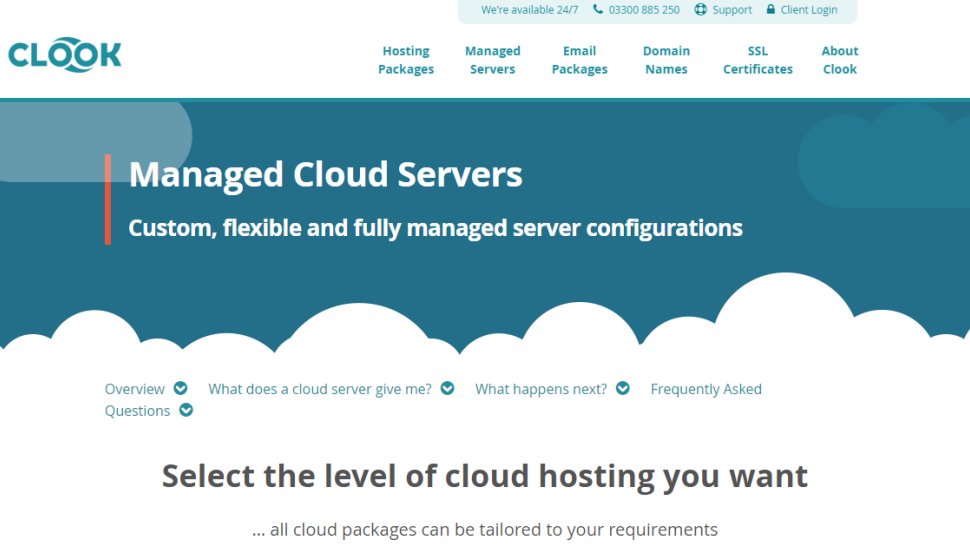
Clook is one of the UK's leading independent webhosting providers, who offer Managed Cloud Servers among their various hosting services.
Again, it's targeted at more basic web hosting needs, but if you're looking for this in the UK market then Clook is up there with the best.
Unlike many other web hosting providers who chase the lowest prices while cutting corners on service, Clook instead invest in some of the best support in the business. This does mean you pay more, but it also means you can enjoy piece of mind because if something goes wrong then you can be assured that Clook are already working hard to address it.
Additionally if you have additional support queries Clook are fast to respond, and rather than script-reading frontline support you're actually talking directly with people who have direct system administration experience of their server network. This avoids the frustration of running round in circles and instead means the job simply gets done.
Because this is a company run by sys admins, it also means that the hardware and network is very solid, and their managed cloud servers are no different. This is a managed service as well, which means you don't have to worry about a thing. While other providers might aim for high uptime, Clook ensures their customer actually enjoy it, resulting in a headache-free service.
Overall, there are cheap hosting providers and complicated cloud platforms out there, but if you simply want rock-solid webhosting and are looking at the UK market then Clook is one of the best options you can go for.
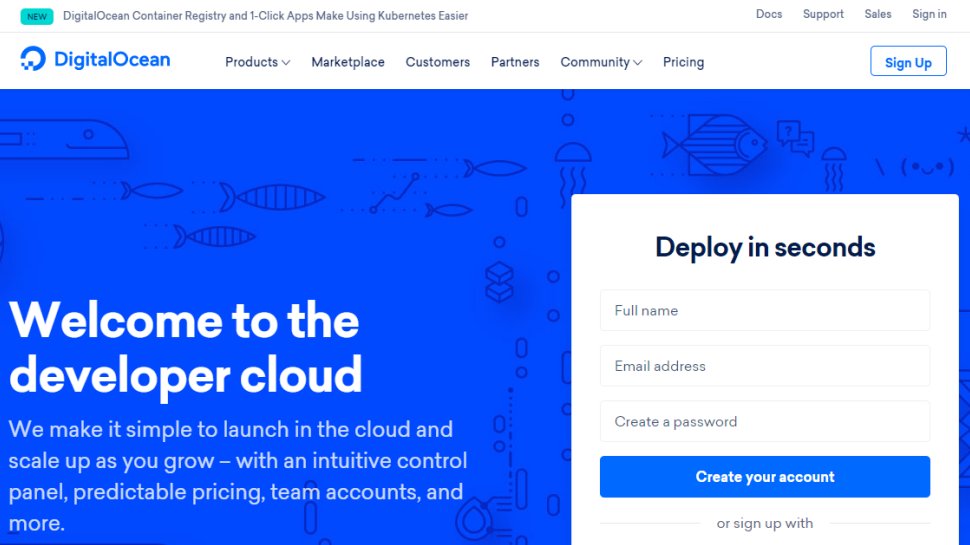
DigitalOcean puts the cloud hosting focus on data as much as websites, providing a background of cloud computing services that make it the ideal place to host and run your own applications in the cloud.
While cloud hosting schemes always involve pooling resources from multiple devices, most do their best to keep you away from the low-level details. You may be able to scale your plan by adding CPU cores, RAM or storage, for instance, but the console will present this to you as a single system.
DigitalOcean's Droplets are based around similar resizable and customizable virtual machines, but that's just the start – the technology has much more to offer.
For starters, the system supports Droplets of different types. If the standard plans aren't enough – priced from $5 (£3.55) a month for one core, 1GB RAM and 25GB storage – Optimized Droplets aim to ramp up your performance by using the best Broadwell and Skylake CPUs, and providing more RAM and storage space.
Individual Droplets have more features than you might expect, including performance monitoring and alerts, snapshots and automatic system-level backups.
There are various interesting ways to work with your Droplets as a group, including setting up a cloud firewall, and using a load balancer to distribute incoming traffic across your infrastructure.
DigitalOcean's transparent pricing is a highlight. You're billed hourly, with monthly caps, ensuring you only pay for the resources you use. Many of the features come for free – monitoring, cloud firewall – while others follow very simple pricing rules. Snapshots cost $0.05 per gigabyte per month, for instance, while backups are priced at 20% of the cost of the virtual machine – easy.
If all you want to do is host a scalable WordPress site, this will probably be overkill, but developers, sysadmins and other more demanding users will appreciate the power and flexibility DigitalOcean offers. Browse the lengthy list of tutorials (which numbers 2,300+ at the time of writing) on the DigitalOcean site to find out more.
You might also want to check out our other website hosting buying guides:
- Best Wordpress hosting providers
- Best E-commerce hosting
- Best dedicated servers
- Best small business web hosting
- Best Windows server hosting
- Best managed webhosting
- Best green and environmental friendly hosting
- Best colocation hosting
- Best email-only hosting
- Best reseller hosting
- Best VPS hosting providers
- Best shared webhosting
- Best cheap webhosting
- Best website builders
- Best overall website hosting providers
from TechRadar: computing components news https://ift.tt/2nt8jqI
via IFTTT
An Interview with AMD’s CTO Mark Papermaster: ‘There’s More Room At The Top’
On the back of a very busy 2019, AMD is gaining market share and is now a performance leader in a lot of CPU segments. The company has executed well not only with a good product but also at a time when its main competition is having manufacturing and production issues, which means AMD is ripe to push boundaries, gain market share, and make noise with a lot of wins. This year AMD’s Ryzen 3000 CPUs and EPYC Rome CPUs both have the new Zen 2 microarchitecture built on TSMC’s 7nm, something that might not have been possible without deep co-optimization between the two companies for a high performance product. AMD is also making strides with its relationships with enterprise OEMs. We touched on these topics (and more) with AMD’s CTO, Mark Papermaster.
from AnandTech https://ift.tt/2QbkvuM
via IFTTT
TureMetal Builds a Fanless 32-Core EPYC PC with an RTX 2070
Turemetal, a maker of cases for fanless PCs, has published photos of a passively cooled system featuring an AMD EPYC processor and an NVIDIA GeForce RTX 2070 graphics card. The computer uses numerous custom components, with the founder of TureMetal stating that this is a custom build for a specific customer, although it uses one of their standard fanless PC cases.
The fanless system built by Turemetal is powered by AMD’s 32-core EPYC 7551 processor, listed as having a 180 W TDP, and GIGABYTE’s NVIDIA GeForce RTX 2070 video card with a 175 W TDP (355W total). These are both equipped into a Supermicro ATX motherboard, and then built inside a commercially available Turemetal UP10 chassis.
Officially the chassis supports a 140 W CPU and a 160 W GPU (300W total), but it looks like its actual capabilities are more impressive, and with a bit of tweaking it can house a rather extreme 32-core processor and a high-end graphics board.
At this time, according to Turemetal's YouTube channel, the system has passed FurMark's full-load test for CPU and GPU for 22 continuous hours without a crash or thermally throttling. In the video, we see a GPU temperature of 88C, and a CPU temperature of 76C, in a 24C ambient room.
Since the Turemetal UP10 was not designed for AMD’s EPYC processors, in order to meet the demands of the customer Turemetal had to build a custom copper heat spreader for the processor along with an appropriate mounting mechanism. The radiator weighs nearly 2.5 kilograms, so we are literally talking about heavy metal here. The test system currently uses an external PSU, but Turemetal says that eventually power supply will be moved inside the PC.
It remains to be seen when and whether the UP10 chassis with AMD EPYC 7551 support will be available commercially - if the custom block will be an 'add-on', or limited to specific customer requests. Meanwhile, good news is that some of Turemetal’s products are now available not only directly from Taobao, but also from Fully Silent PCs in the US and will soon be available in Europe shortly, reports FanlessTech.
Related Reading:
- A Super Fanless Chassis from TureMetal: For DIY & 0 db Workstations
- Noctua Concept Fanless CPU Cooler: Up to 120W Of Cooling Performance
- Compulab Launches Airtop3: A Fanless PC with Core i9-9900K & Quadro RTX 4000
- Streacom DA2 Fanless: The All-Aluminum Silent Chassis
Source: Turemetal/Twitter, FanlessTech
from AnandTech https://ift.tt/359RILm
via IFTTT
Limited time iPhone 11 deals - you'll have to get in quick to grab these bargains
iPhone 11 deals are keeping us on our toes at the moment. Since the very best came and went about a month ago around Black Friday, contract prices have been going up and down like the cheap yo-yo you got in your Christmas cracker.
So if you've snoozed and, erm, losed and missed out on some great iPhone 11 deals in the last few weeks, then we have some very good news for you. Mobiles.co.uk has once again slashed the upfront price of some of the retailer's best EE tariffs on Apple's 2019 handset with bills starting at a really eye-catching £29 a month.
But our contacts at Mobiles.co.uk have told us that this price reduction is strictly for a limited time only and that they'll shoot right back up at midday on New Year's Eve. So stop listening to us banging on and cast your eyes downwards to see three of the UK's best iPhone 11 deals you can get...for now.
- Keep the bargains coming with our guide to the January sales
What makes the iPhone 11 so good?
The iPhone 11 is the cheapest of Apple's latest trio and yet, really isn't much of a downgrade. You still get Apple's new incredibly fast CPU, a 6.1-inch screen, IP68 rating and even a 3046mAh battery, enough to keep you going all the way through the day on one charge.
Read our full iPhone 11 review
- See the competition with our Samsung phone deals and Huawei Phone deals guides
from TechRadar: computing components news https://ift.tt/2teLi0m
via IFTTT
Sunday 29 December 2019
PS5 release date, specs, news and rumors for Sony’s PlayStation 5
Sony's next-generation PlayStation console is the PS5 (PlayStation 5) and it's landing at the end of 2020.
In early 2019, we heard from Mark Cerny, the chief architect on Sony's next console, that the company is working on the successor to the PS4 Slim and PS4 Pro. While he didn't share the official name or release date at the time, Cerny did shed some light on a few choice details about what we could expect from its hardware.
We found out that the PS5 will still play discs, for one – but as to the exact hardware specifications, and how it will link up with Sony and Microsoft's plans for game streaming, we've remained largely in the dark.
However, in recent months, Sony has been drip-feeding us juicy titbits such as an official PS5 release window, name and a few key details about features.
In addition, we've had some surprising leaks, in the form of a Sony-registered patent that seems to show off the PS5's general shape, button inputs, and cooling vents – confirmed to be the PS5 dev kit in a leaked photo – though we expect the end product design will be different for the PlayStation 5's late 2020 launch.
With 2020 creeping closer, Sony can only keep the finer details of the next-generation PlayStation a secret for a little longer - especially with Microsoft officially unveiling the Xbox Series X. But between the rumored specs, likely next-gen titles, and official features we are aware of, there's plenty to keep us busy for now.
Here's everything we know about the PS5 so far, and what we hope will be revealed the closer we get to launch.
PS5: key facts
- What is it? The Sony PS5 will be the next-gen PlayStation console, replacing the PS4 Slim and PS4 Pro.
- When will it release? "Holiday 2020" so between October and December 2020.
- What can I play on it? Only a few titles have been confirmed, but expect all of Sony's big franchises – as well as in-development exclusives like Ghosts of Tsushima.
- Will PS5 have VR? Oh yes. The next-gen console will be compatible with current PSVR hardware and there are rumors of PSVR 2.
- What will the PS5 cost? The PS4 and PS4 Pro were both $399 / £349 at launch, but we expect the PS5 will cost somewhat more. Leaks have suggested around the $499 mark.
PS5 release date
Sony has officially confirmed the PS5 will release "Holiday 2020", aka between October and December 2020. A leak has suggested that the release date will be November 20, 2020 but that's yet to be confirmed. It's in the right window, though, and it does leave time before Christmas to get those orders in.
This will put the PlayStation 5 in direct competition with Microsoft's Xbox Series X (formerly Xbox Project Scarlett), which is releasing during the same period. Game on.
PS5 price: how much will it cost?

Sony hasn't officially confirmed a PS5 price just yet, so we can't say for sure what it'll be. There have, however, been rumors. A leak has suggested that the console will cost $499 in North America when it launches. Naturally this should be taken with a pinch of salt, but it would be welcome news if the console did launch at this price as it's only $100 more than the launch price of the PS4 and PS4 Pro.
There's also been a less believable rumor claiming the PS5 will cost up to £900 - but Sony has already debunked that.
We can expect that the console's price will be in line with the technology it uses but Sony will also have to be aware of its competition. It's unlikely that Microsoft will want to make the same mistake it made in the last generation, with the prohibitively high price point of the Xbox One, so Sony will have to ensure it doesn't make a similar mistake in the next generation by making the PS5 too expensive.
PS5 specs

Ghost of Tsushima (Image Credit: SuckerPunch)
- Bespoke 8-core AMD chipset (based on third generation Ryzen architecture and with Navi GPU)
- SSD storage system
- Backwards compatibility with PS4 games and PSVR hardware
- 3D audio
- 8K TV support
So what is the PS5 packing under the hood? We don't know a huge amount about the PlayStation 5's specs, but here's what we do know.
That AMD one-two-punch of CPU and GPU unlocks the powers of ray tracing, an advanced lighting technique that can bring next-level immersion to gaming visuals. It's a Hollywood technique that's used in big-budget CGI spectacles, putting the level of visual fidelity you can expect into context.
Ray tracing is done by GPU hardware rather than software level, Mark Cerny told Wired. “There is ray-tracing acceleration in the GPU hardware,” Cerny explained.
With 8K TV support comes far more detailed textures, and much larger ones at that. The news of a bespoke SSD drive will be heartening then – just because the games will be becoming more complex, that doesn't mean they'll be slower to load too. It's estimated that the new SSD is 19 times faster than traditional SSD storage methods (but given the speed difference between the SSD and the optical drive, installation of games will be mandatory).
Not only that, by harnessing the power of the SSD, developers could potentially reduce the install sizes of games as “there is no need to duplicate data to compensate for slow seek times that optical drives and HDDs have.”
The PS5 will benefit from simplified data management due to its SSD, and this will allow players to have more control over installing and removing games. This will allow players to install (or remove) only certain parts of a game. So instead of installing the full game, you could choose to just install the single-player mode and then do multiplayer later - or vice versa.

Uncharted 4: A Thief's End (Image Credit: Naughty Dog)
Physical games for the PS5 will use 100GB optical disks, inserted into an optical drive that doubles as a 4K Blu-Ray player and the next-generation hardware will boast a completely revamped UI.
Speaking about the new UI to Wired, Cerny said: "Even though it will be fairly fast to boot games, we don't want the player to have to boot the game, see what's up, boot the game, see what's up.
"Multiplayer game servers will provide the console with the set of joinable activities in real time. Single-player games will provide information like what missions you could do and what rewards you might receive for completing them - and all of those choices will be visible in the UI. As a player you just jump right into whatever you like."
Audio will reach a new "gold standard" on PS5 too, according to Cerny, thanks to a new audio engine that will deliver immersive sound – particularly if you're using headphones. While the details remain unclear, expect something resembling the experience seen with a Dolby Atmos set-up.
Sony's PS5 next-generation console will also offer improved cloud gaming performance and "dramatically improved graphics rendering" power.
That's the word straight from the company itself, as it showed off a sneak peak during a corporate strategy presentation.
In a statement sent out following the presentation, Sony said the "two keywords for the future direction of PlayStation are 'immersive' and 'seamless'", with the 'immersive' experience "created by dramatically increased graphics rendering speeds, achieved through the employment of further improved computational power and a customized ultra-fast, broadband SSD".
The company also reinforced the importance of its cloud-gaming plans with Playstation Now, and somewhat surprisingly doubled down on its underused Remote Play feature, saying the "evolution" of this would in the future "provide a seamless game experience anytime, anywhere".
Remote Play is already available as part of the PS4 package, enabling you to stream a game direct from the console to a computer, smartphone, tablet or PS Vita handheld console. But Sony says that going forward it will be "leveraging the latest computing, streaming, cloud, and 5G technologies" to allow it, and the performance of PlayStation Now, to improve.
If that's not enough, Sony has confirmed the PS5's 'incredibly powerful' backwards compatibility will let you play online with PS4 players.
There have also been rumors that the PS5 could be backwards compatible with the PS3, PS2, and original PlayStation, meaning its games library could stretch right back to the glory days of the mid 90s.
PS5 design
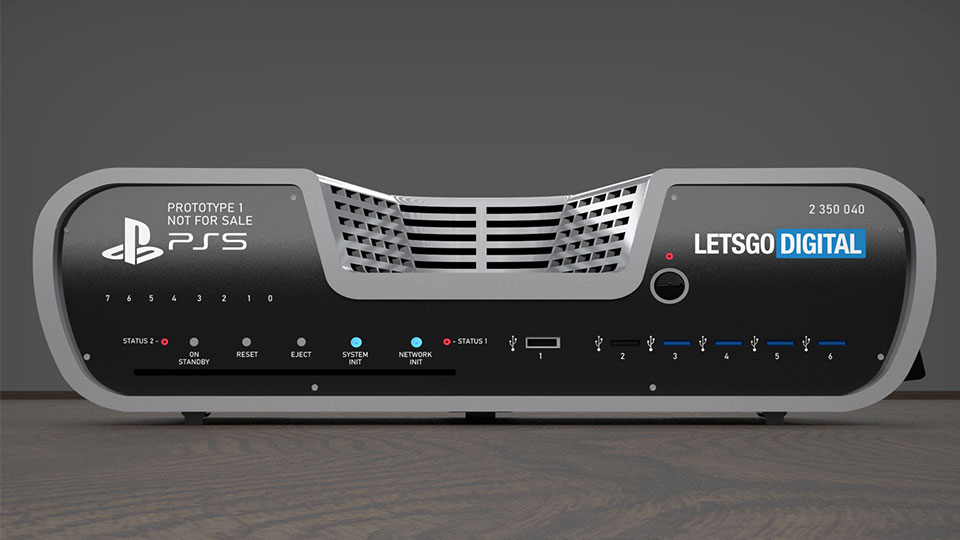
We haven't actually gotten an official look at the PlayStation 5 yet but, if several leaks are to be believed, Sony's next-generation console will sport a very different look to its predecessors.
The above render, courtesy of Let's Go Digital, is based on a spy shot received by Zone of Tech, which shows what's alleged to be a real, working PS5 development kit in its natural habitat – the offices of an anonymous PlayStation 5 developer.
The image, if legitimate, all-but confirms the many leaked rumors and renders concerning the PlayStation 5's hardware design, one that sports an unusual V-shaped cavity and excessive amounts of ventilation.
What does the image show us? There's a number of buttons: On/Standby, Reset, Eject (for the double layer 100GB-reading Blu-ray drive), System Initialisation and Network initialisation, all on the front left. There are also a number of status lights, numbering '0' to '7', which likely relate to CPU cores engaged, but could also be a status light for controllers connected.
To the right there are 5 USB ports (one USB 2.0 and five likely USB 3.0 ports – the final port being obscured by a cable), as well as a USB type B port. A small circle above could well be a camera built into the console, according to earlier patent filings.
Interestingly, rubber feet appear to be on the top side of the console, suggesting that devs are being encourage to either flip the console for stress testing and convenience, or to stack them when working on demanding games.
Even if we are to assume this is a PS5 dev kit for real out in the wild, it should only really be used to speculate on what the final design of the consumer console will be, rather than considering it wholly indicative on the machine to come.
Dev kits are specially designed to be robust, and to support a console working under extreme load so as to allow the developers to push their creations to the maximum without frying the hardware they are working on. It's also designed, at this stage, to help find any flaws in the final PS5 consumer hardware industrial design.
With Sony likely a full year away from the launch of the PlayStation 5, there's plenty of time for its team to create something a little less alien-looking.
- PS5 will double as a 4K Blu-ray player - here's why that matters
PS5 controller

The PS5 will come with its own controller, according to Sony. The PS5 controller (we don't know the official name yet) will include haptic feedback to replace the DualShock 4's rumble technology. This aims to improve the controller's feedback and therefore player's immersion.
The PS5 controller will also feature adaptive triggers which Sony says have "been incorporated into the trigger buttons (L2/R2)". These adaptive triggers will allow developers to program the resistance of the triggers to simulate actions more accurately.
A recently published patent suggests new back buttons are coming to the PS5 DualShock controller – perhaps along similar lines to the Back Button Attachment that Sony just launched for existing DualShock 4 gamepads.
But what will it look like? According to a Sony patent for a new controller, published by the Japanese patent office (via VGC), the PS5 controller could look very similar to the DualShock 4 - with some key differences.
For a start, the potential PS5 controller seems to have a slightly chunkier design, built-in microphone, larger triggers, no light bar and smaller sticks. It also seems the DualShock 4's micro USB port has been replaced by a smaller USB-C port, which is placed on the top rather than the bottom of the controller.
The lack of light bar does make us question how the PS5 would track the controller via when it comes to PSVR and PS Camera games. Usually this is done via the PS Camera, so we're hoping the console will have a different means of tracking the controller otherwise compatibility will suffer. Unless, of course, Sony is gearing up to move solely onto PSVR 2. However, this doesn't seem likely as Sony has promised the PS5 will be backwards compatible with PSVR.
It also looks like the stereo headset jack and extension port at the bottom of the headset has been replaced by two larger circular ports. We think these will still be for plugging in headsets, but the two jacks could be headphone and microphone slots respectively, to increase compatibility with headsets. There's also a rectangular design that seems to wrap around the headset, which is potentially for compatibility with a charging dock. Again, this is all speculation on our part.
- PS5 controller: release dates, news and rumors
PS5 games

The entire PS4 library, including PSVR games, will be supported by the PS5. That much is known. But we're now hearing more about confirmed - and rumored - PS5 games.
At this point, any first-party PS4 game in the pipeline – from Ghost of Tsushima to The Last of Us 2, would be prime candidates for PS5 cross-gen upgrades. We've also heard enough chatter around a Horizon Zero Dawn sequel and new God of War game to assume we'll be seeing both land on the PS5 console.
But what about third-party titles? We've had confirmation that Gearbox's new IP Godfall is coming exclusively to PS5, as is a new title from Bluepoint Studios. In addition, Ubisoft has confirmed that Watch Dogs: Legion, Rainbow Six Quarantine, and Gods and Monsters are all coming to Xbox Series X and PlayStation 5.
Meanwhile Electronic Arts has confirmed that Battlefield 6 is on the way, and that it's coming to next-generation consoles - which probably means PS5.
There's still no confirmation on what the PS5's launch titles will be but we're expecting first-party games to take the lead.
In addition, Sony has confirmed the PS5 will prioritize AAA games over indie games in an effort to focus on "serious gamers".
- PS5 games: all the games confirmed and expected on the PlayStation 5
What about a PS5 Pro?

A rumor has cropped up suggesting that Sony will cut to the chase and launch the PlayStation 5 Pro at the same time as its base-model PS5.
As spotted by Wccftech, noted Japanese games journalist Zenji Nishikawa made the claim in a new video on his YouTube channel, and while that kind of thing normally wouldn't be considered a rock-solid lead, Nishikawa has proven accurate in the past with his predictions of the PS4 Pro and Switch Lite.
According to Nishikawa, the PS5 Pro will cost around $100-$150 more than the basic PS5 console. The report states that Sony is taking this approach because it has "acknowledged the interest in a high-end model and wants to give players what they want right from the beginning of the generation".
- Tired of future-gazing? Why not check out the best PS4 games right now.
- Already got a PSVR? Follow these steps to jump into virtual reality.
from TechRadar: computing components news https://ift.tt/1cK2UyM
via IFTTT
